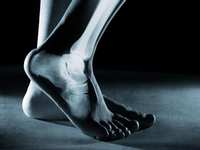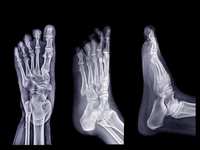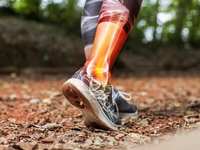Marathon Foot: How Runners Can Prevent It and How to Treat It

Running, especially long-distance running, has never been more popular in the United States as more and more people have laced up and headed to the great outdoors to stay in shape since the onset of the pandemic.
“Since 2020, 59.1 percent of active adults say that exercising outdoors, such as running, is one of the top ways they’re staying fit, per RunRepeat Fitness Trends Report,” says LiveStrong.
And people are not only running but they are channeling their inner Forrest Gump and running marathon distances.
“As racing came back in 2022, the share of runners on Strava who ran a marathon nearly doubled compared to 2021,” reported Strava with the number of runners who ran a marathon in the U.S. doubled.
At Sweeney Foot & Ankle Specialist, we understand the needs of marathon runners better than others as The Woodlands is home to the fastest marathon course in Texas, and a popular qualifier for the Boston Marathon, as well as one of the premier triathlons in the country, the IRONMAN Texas.
Along with the exhilaration of running 26.2 miles can come the punishment that your feet take, and some runners may suffer from a condition known as “marathon feet” – pain resulting from inflamed soft tissues of your feet from the hours of pounding on the pavement on race day.
What is Marathon Foot?
While long-distance runners and marathoners can experience a variety of issues with their feet including blisters, calluses, toenail problems, plantar fasciitis, stress fractures, and other forms of foot discomfort or pain – marathon feet are their own special condition.
Lewis G. Maharam, author of the “Running Doc’s Guide to Healthy Running: How to Fix Injuries, Stay Active, and Run Pain-Free” helped coin the phrase after getting phone calls in the middle of the night from patients, as he describes in the book:
“Doc, I just finished my first marathon yesterday, in 5:40.59! What a great time! I followed all your advice, but last night – starting at about 3 a.m., both my feet started killing me. I could not walk! It hurts even to have my comforter rest on them! Is this normal? What is this? How can I prevent it?”
Maharam goes on to say that “what my middle-of-the-night callers are describing if there is no bony tenderness or swelling, is what I call “marathon feet.” In basic terms, it is inflamed soft tissues of the feet from the street pounding of 26.2 hard miles (although I have also seen it at the half-marathon, 13.1-mile distance). We most commonly see this in people who have trained on softer surfaces (like the reservoir track in New York City) than on a paved road or who race in thin racing flats when they did not train in them. The inflamed soft tissues get more and more painful until it’s truly hard to walk or even put a comforter over them.”
Why Does Marathon Foot Happen?
Several factors contribute to the development of Marathon Foot:
- Repetitive Impact: Long-distance running involves continuous and repetitive impact on the feet, leading to stress on the bones, joints, and soft tissues.
- Improper Footwear: Wearing ill-fitting or worn-out running shoes can increase the risk of foot problems. Shoes that lack proper support or have inadequate cushioning can contribute to discomfort.
- Training Intensity and Volume: Overtraining or sudden increases in training intensity and volume without proper conditioning can strain the feet.
- Running Surface: The type of surface runners train on and race on can affect the impact on the feet. Hard surfaces may increase stress and contribute to foot issues.
How Can I Prevent Marathon Feet?
Preventing marathon feet starts well before race day as there are strategies you can use while training and then there are race day prep things you can do.
Let’s look closer at the prevention strategies:
Training Leading up to Race Day:
- Gradual Progression: Incrementally increase mileage and intensity during training to allow the feet to adapt gradually.
- Proper Footwear: Invest in high-quality running shoes that provide adequate support and cushioning. Ensure that shoes are replaced regularly to maintain their effectiveness.
- Cross-Training: Incorporate cross-training activities to reduce the repetitive impact on the feet and improve overall fitness.
- Strength and Flexibility: Include foot-strengthening exercises and stretches in your training routine to enhance the resilience of the feet.
Race Day Preparation:
- Shoe Fit Check: Ensure that your race-day shoes are well-fitted and broken in. Avoid using new shoes on race day.
- Moisture Management: Use moisture-wicking socks to minimize friction and reduce the risk of blisters.
- Hydration and Nutrition: Proper hydration and nutrition contribute to overall foot health. Dehydration can affect skin integrity and increase the risk of foot issues.
How to Treat Marathon Foot
If marathon foot does occur, there are some treatment steps that runners can take to alleviate the pain:
- Rest: Allow adequate time for the feet to rest and recover. Reduce or modify training until the discomfort subsides.
- Ice and Elevation: Apply ice to reduce inflammation and elevate the feet to alleviate swelling.
- Compression: Consider using compression socks or sleeves to reduce swelling and promote circulation.
- Anti-Inflammatory Medication: Non-prescription anti-inflammatory medications may be used under the guidance of a healthcare professional.
"If you experience “marathon feet,” it can take 2 to 3 days post-race for your feet to stop hurting. If at any point you feel tenderness in a bony area of your foot, see a podiatrist to make sure it isn’t a stress (or full) fracture in your foot," advises Dr. D. Sean Sweeney, D.P.M.
Other Foot Ailments for Runners to Watch Out For
In addition to Marathon Foot, long-distance runners should be vigilant about other foot conditions, including:
- Plantar Fasciitis: Inflammation of the plantar fascia, causing heel pain.
- Achilles Tendinitis: Inflammation of the Achilles tendon, often resulting from overuse.
- Stress Fractures: Microscopic fractures in bones due to repetitive stress, commonly seen in long-distance runners.
- Blisters and Calluses: Friction-induced skin issues that can be prevented with proper footwear and moisture management.
Long-distance runners can maintain foot health through proper training, suitable footwear, and attentive self-care.
If your problems persist or worsen, make an appointment with Sweeney Foot & Ankle Specialists to have your feet examined by our doctors of podiatric medicine in our state-of-the-art offices in The Woodlands and Magnolia.


















